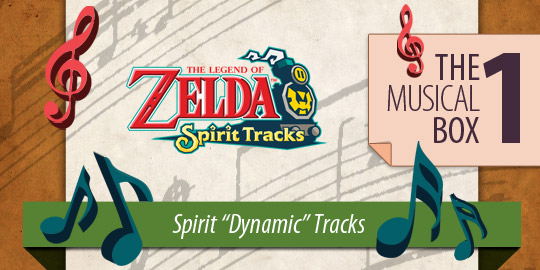The Musical Box features 30 articles focusing on game music production and implementation. The first edition is dedicated to the Nintendo DS Game The Legend of Zelda - Spirit Tracks.


You can't talk about music for videogames without mentioning one of the best franchises ever made in this industry: The Legend of Zelda. This series is known for its memorable and amazing music, mainly created by Japanese composer Koji Kondo, who also composed the undeniably classic tunes of Super Mario Bros. and many other Nintendo masterpieces.
For this particular edition of The Musical Box, I chose a recent game from the franchise: Spirit Tracks, released in December 2009 for the Nintendo DS.
The set-up
The story of Spirit Tracks begins when our hero Link sets out to collect his well-deserved certificate of train engineering from the hands of the beloved princess Zelda. On his way to the castle, something strange happens: the train tracks start to disappear! Zelda believes that the origin of the problem is somehow related to the mysterious Tower of Spirits, and this is the beginning of our adventure.
Before I present the memorable moment to you, I would first like to explain some musical concepts.
As a composer and avid old-school hardcore gamer, I am always interested in music that changes according to the actions of the player. This kind of composition is very unique and closely connected to the most important aspect of a videogame experience: interactivity. In the video game industry, music that adapts itself is called "dynamic" music or "adaptive" music, but you'll find other synonymous terms out there.
Spirit Tracks grabbed my attention with its innovative approach to "dynamic" music. Most modern games feature "dynamic" music in a very similar way. For example, when you face a tough enemy (or many of them) the music becomes more intense. If you defeat all of your opponents, the music reverts to a calm/softer version. In 90% of games, this is the extent of the "dynamic" music you will listen to.
Spirit Tracks' soundtrack is different. Yes, the music changes when you face enemies, but this is not all. In fact, even the most mundane and simple actions are supported by astonishing "dynamic" music. It is during these actions that we find our memorable musical moments in this game.
The Moment
You spend many hours riding the train across Hyrule, and if you pay attention to the music, you'll notice that it changes according to the way you ride it. If you ride it slowly, the music is played with fewer instruments. As you gain speed, more instruments are added and the music sounds "fuller". If you ride on reverse, you will also hear that certain instruments are muted and others are added to the music, creating a different experience. Finally, if you stop, you'll hear a different version of the tune altogether.
I should also add that the sound of the train engine is synchronized with the tempo of the music. The sound effect of the engine literally sounds like a percussive instrument of the music! Very clever, isn't it?
The second memorable moment occurs when you reach the Tower of Spirits. Notice that as you climb the stairs, more instruments are added to the song. If you go down the stairs, the music becomes "simple" again. You can only hear the full version of the music when you reach the top of the tower, at which point you'll also be very close to the end of the game. This reinforces the feeling of an epic victory! You saved the world, you saved Zelda, you have a lot of rupees and you can listen to the full song of the tower. The music is an homage to the biggest hero of all time: you!
The Impact
Playing The Spirit Tracks really changed my conception of "dynamic" music in games. I was impressed not only by the music itself, which is beautiful, but by the way it was implemented as well. It's aesthetically simple, but effective, memorable and made me realize that a simple train ride can be one of the most unforgettable musical experiences of my life.
Special thanks: Gilliard Lopes, Rafael Kuhnen, Fernando Secco, Sandro Tomasetti, and Rafael Martins (Sommastudio).
Read more about:
BlogsAbout the Author(s)
You May Also Like









